Types of Dermatitis in Dogs - Causes and Treatment



See files for Dogs
Dermatitis in dogs is a term which refers to the inflammation of a dog's skin, a symptom which has many causes. Whether due to infection, sensitivity, parasites or any other issue, dermatitis can be very troubling for the dog. Not only does it cause discomfort and pain, but the damaged skin is made vulnerable to possible bacterial infection and other complications. This is in addition to the damage to the dog's health caused by the underlying cause of canine dermatitis. The severity of dog dermatitis ranges from minor to extensive, the latter of which can threaten the dog's life.
At AnimalWised, we help you know what to expect with your animal by providing the different types of dermatitis in dogs. We look at the causes and treatment of each to understand what to expect if your dog is diagnosed with skin inflammation.
- What is dermatitis in dogs?
- Causes of dermatitis in dogs
- Types of dermatitis in dogs
- Atopic dermatitis
- Flea allergy dermatitis (FAD)
- Food allergy dermatitis
- Fly strike dermatitis in dogs
- Acral lick dermatitis
- Acute moist dermatitis
- Contact dermatitis
- Seborrheic dermatitis
- fungal dermatitis
- Mite dermatitis
- Dermatitis in puppies
- Is dermatitis in dogs contagious?
- Dermatitis in dogs treatment
- Home remedies for dermatitis in dogs
What is dermatitis in dogs?
Before we talk about the different type of dermatitis in dogs, it is helpful to provide an overview of this condition. It is not a specific disease in itself. In its most basic form, it refers to the symptom of skin inflammation. When we call a condition dermatitis, it is usually a reference to a set of symptoms rather than a standalone disease. The inflammation can manifest in various ways, including vesicles, erosions, ulcers, nodules and other symptoms.
When the skin inflammation is linked to a specific cause, it is then known as a disease. These different types of dermatitis may also occur concurrently with other diseases or as a result of another disease. This is known as a comorbidity. Comorbidities with dermatitis are common in dogs, both physiological and psychological[1].
Causes of dermatitis in dogs
There are many causes of dermatitis in dogs that result in classification into different types. This is one of the reasons it is so important to go to a veterinary clinic when you see skin inflammation in your dog. Providing a differential diagnosis allows the veterinarian to carry out the correct treatment. This will not only treat the dermatological inflammation, but the underlying cause which may be one of the following:
- Fungus
- Yeast
- Mites
- Fleas
- Food Allergy
- Contact with an allergen
- Licking a certain area excessively
While the most common, these are not the only causes of dermatitis in dogs. In the following sections, we look at the different types of canine dermatitis in more detail with photos to provide a better idea of the clinical picture.
Types of dermatitis in dogs
Each type of dermatitis in dogs has its own differential symptoms and its own treatment. This is because the underlying cause is related to a range of issues such as from allergies, irritants and infections. They can also be further complicated by underlying health conditions. Understanding the differences between the following types of dermatitis in dogs is vital:
- Atopic dermatitis
- Flea allergy dermatitis
- Food allergy dermatitis
- Fly strike dermatitis
- Acral licking dermatitis
- Acute moist dermatitis
- Contact dermatitis
- Seborrheic dermatitis
In the next sections, we will see these differences in clinical picture and treatment in more detail. We highlight the symptoms of each one, as well as look at important factors in dog care such as disease prevention. Where possible we look at photos of types of dermatitis in dogs.
Atopic dermatitis
Among the types of dermatitis in dogs, atopic dermatitis is one of the most common. Its cause is not well understood, but it is known to have genetic, environmental and immunological factors. Sometimes this is in the form of sensitivity to allergens. It most often affects young dogs between 1 and 3 years of age. It usually develops seasonally, but can reoccur throughout the year.
Symptoms of atopic dermatitis include the following:
- Scratching (especially around the ears)
- Hair loss
- Lesions on the skin
- Secondary bacterial infections
- Licking of the paws
- Sneezing
- Ocular discharge
- Dark patches on fur
The dark patches are caused by the oxidization of salvia on affected body parts. The dog keeps licking their paws or other areas to help reduce the discomfort, resulting in excessive saliva deposits.
The reason for these symptoms of atopic dermatitis is an excessive reaction by the dog's immune system. While genetics and environment are influences, removing any potential allergens in the dog's environment which may trigger a reaction. We do this by:
- Vacuuming the house daily
- Not shaking blankets, sheets or other bed clothes in the dog's presence
- Minimizing walks as much as possible during windy days
- Avoiding the hours of greatest pollen concentration
- Bathing the dog if they have come in contact with an allergen
Treatment for canine atopic dermatitis often requires medicated shampoos, disinfectants and antihistamines to relieve symptoms such as itching. If secondary bacterial infections occur, antibiotic treatment will likely be necessary. Our veterinarian may also recommend adding foods with omega-3 rich foods for dogs to improve skin repair.

Flea allergy dermatitis (FAD)
This type of dermatitis in dogs is relatively common, occurring in canines with a sensitivity to flea saliva. When the flea bites them, the saliva reactions with their immune system. This results in hair loss and inflamed welts on the skin. These lesions commonly appear on the dog's hindquarters, base of the tail and inner surface of the thighs. It can be very itchy, causing wounds to appear as the dog repetitively scratches their skin. This can also result in secondary infections. The lesions can darken and thicken if left untreated.
The treatment of flea allergy dermatitis in dogs begins by controlling the fleas. This can be difficult in many cases, so they will need to take various precautions. Such precautions include the following:
- Treat all animals that live together.
- Maintain preventive treatment throughout the year, even if we do not observe another flea infestation.
- Products must be used that eliminate fleas in all the stages of their life cycle (eggs, larvae and adults) to ensure that we eliminate all possibility of contact.
- Vacuum the house frequently and frequently wash any beds or covers used by the dog.
- You may require pest control to completely remove the flea infestation from the home.
Ensuring you remove your dogs fleas is important for the health of everyone in the home. We explain more about why this is so with our article on a dog with fleas sleeping in your bed.
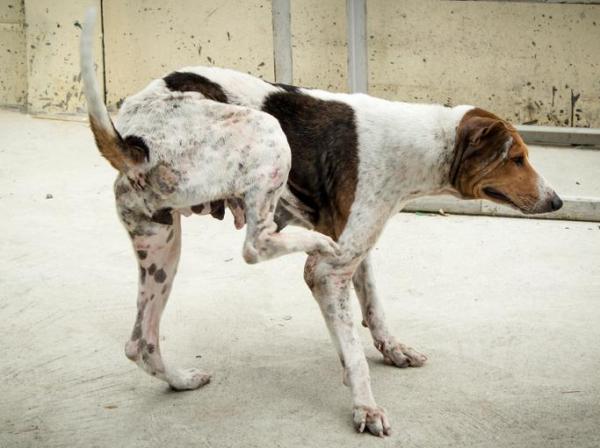
Food allergy dermatitis
One of the most important allergens to consider in dogs is those related to food. Allergic reactions to food can vary greatly in clinical symptoms. These are largely determined by the level of sensitivity in the dog. Some dogs my have a mild allergies which result in minor gastrointestinal symptoms. Others can be so sensitive that even a small amount of food can induce anaphylactic shock in the dog.
Another potential symptom of food allergies in dogs is dermatitis. When this happens, the skin turns red and welts appear on the ears, rump, back of the legs and lower part of the body. The dog will react to foods such as meat, eggs, fish or additives. To treat this problem, a hypoallergenic or assimilation diet is imposed for several weeks. This limits eliminates certain ingredients in their diet as a process of elimination to avoid reactions.
It is also important that the dog has not tried these ingredients in the past. If the symptoms improve, the diagnosis is confirmed, which is confirmed by reintroducing the suspect food. If the dog worsens, it can be assured that it suffers from food allergy dermatitis, in which case the diet should be maintained. For more information, don't miss the following article: " Food allergy in dogs - Symptoms and treatment ."
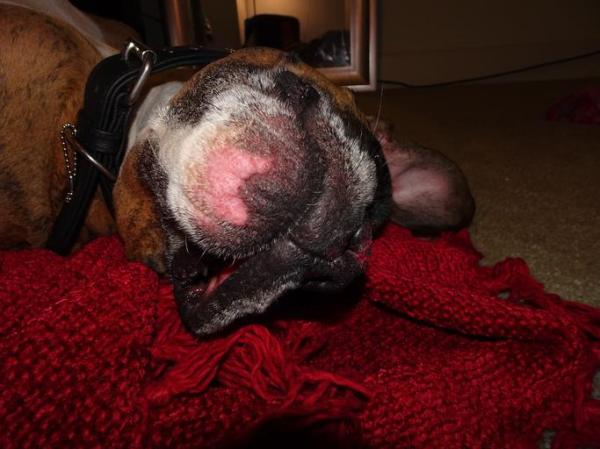
Fly strike dermatitis in dogs
This canine dermatitis is also produced by the bite of a pest, in this case insects from the order Diptera. This includes all flies, as well as mosquitos and other species. It commonly results in dermatitis lesions appearing on the tips of the dog's ears. If left untreated, the ear will likely develop a serrated appearance due to the flies eating at the pinna, as seen in the photo below. The dog will scratch their ears and shake their head to relieve the discomfort.
Fly strike dermatitis is a particular problem in dogs with floppy ears. Dogs that live outside in the summer are also more prone to this type of canine dermatitis. In these cases, we will likely see the flies frequently pestering the dog. A proliferation of flies often influences this problem, so it is important to control fly populations or to shelter our dog from them. We should keep the dog indoors until at least when the wounds have healed. Insect repellant can also be very helpful to prevent fly strike dermatitis.
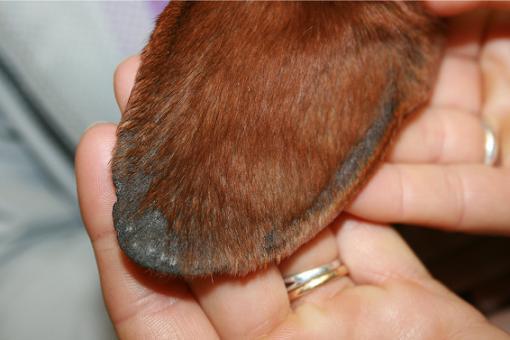
Acral lick dermatitis
Also known as lick granuloma in dogs, acral lick dermatitis often occurs due to psychological stress. An open ulcer like the one seen in the photo below occurs due to compulsive licking by the dog. It usually appears on the front legs of short-haired dog breeds.
The reasons for the licking are varied and can be due to boredom, trauma, neglect or any source of emotional stress. It is also possible that an injury or pain present in the affected area is the reason for the dog's constant licking. Frequent licking causes the skin to thicken and harden, but the granuloma itself will be seen as an open lesion. The dog will have licked the hair away from the affected skin.
This underlying cause of lick granuloma needs to be addressed to stop them licking in this way and causing the dermatitis. We will need to go to the veterinarian since a physical problem needs to be ruled out before we consider a psychological source of the licking. A dog ethologist may be helpful in determining the problem and providing practical help to overcome their anxiety.
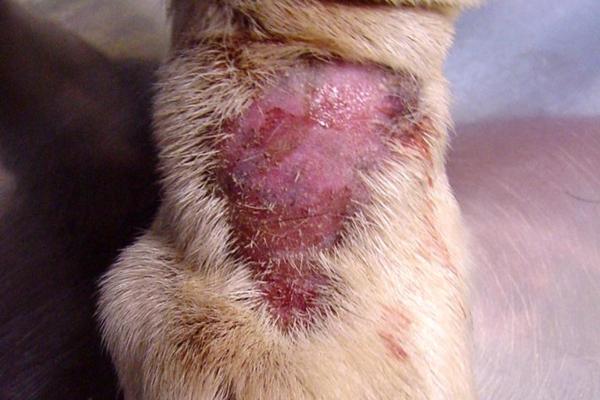
Acute moist dermatitis
This type of dermatitis in dogs results in something known as hot spots in dogs. These are soft pink lesions that appear suddenly (see photo). They are very painful and can be of variable size with bad odor and purulence. The dog can spread this type of dermatitis by licking various parts of the body. They are particularly common in dogs with a thick coat and they appear just before molting.
In addition to dead hair, parasites, allergies, infections or even poor hygiene can result in acute moist dermatitis. Since the lesions can be very painful, the veterinarian may need to sedate the dog to disinfect them. Both topical and oral medications are used to treat the underlying cause of the dermatitis. They may also require an Elizabethan collar to prevent licking the area as the hot spots heal.
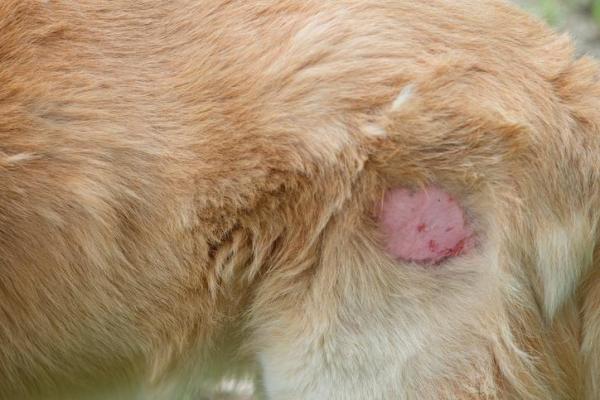
Contact dermatitis
This type of dermatitis in dogs is caused by contact with an irritating element that results in a bad reaction. It is typical for this to occur in the chin or lip area due to a reaction from plastic dog bowls. They are also common on the feet, flanks or rear since these areas commonly come in contact with the ground on which irritants can be present. The reactions are often due to household chemicals such as detergents, paints and solvents.
Red bumps and very reddened skin will be seen at the points of contact with the irritating substance. Sometimes a reaction occurs with only a single exposure. Some dogs may suffer from allergic contact dermatitis, which is caused by repeated exposure to the irritant and affects a larger area of the body. It is caused by products such as antiparasitic collars, shampoos, leather, grass, some drugs, plastic or rubber. Once the causative agent has been identified, removal from the environment should stop episodes of contact dermatitis in dogs.
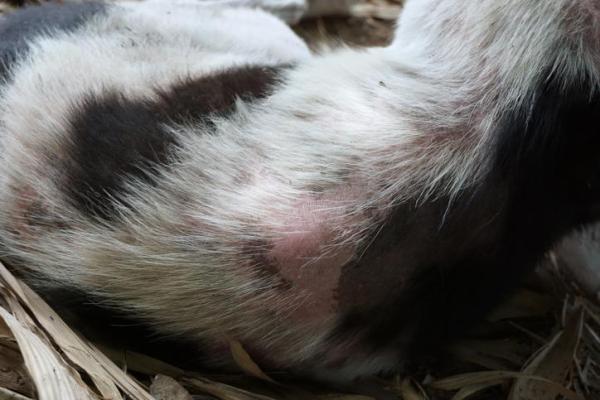
Seborrheic dermatitis
Also known as seborrhea, seborrheic dermatitis occurs when the sebaceous glands produce an increased amount of sebum. This can be the result of another health issue or disease such as fungal infections, allergies, endocrine disorders or autoimmune diseases. There may be some genetic influence since the genes can control the level of sebum production in the glands.
There are two types of seborrheic dermatitis in dogs, dry and oily. The difference between them is in their symptoms. Dry seborrhea causes the dog to produce dandruff in the form of dry flakes. Oily seborrhea causes greasy buildup on their coats and a foul odor. In both cases, dermatitis in dogs causes itching. In oily dermatitis, the this itching intensifies, causing the dog to scratch more intensely and develop wounds on the skin.
Before establishing treatment, it is necessary to identify the cause. Once the diagnosis is made, the veterinarian will most likely prescribe an antiseborrheic soap and vitamin supplements. Likewise, it is advisable to offer foods rich in omega 3 fatty acids to strengthen the coat.
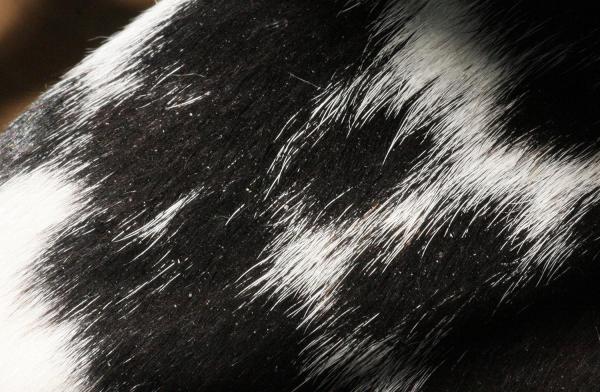
fungal dermatitis
Malassezia in dogs is the most common type of fungal dermatitis in these animals. Malassezia is a yeast that remains naturally in the dog's body: When this yeast multiplies uncontrollably, dermatitis can develop. This increase can happen for multiple reasons, such as an allergy, a hormonal disease, the presence of parasites, among others. Identifying the cause will determine the treatment.
The symptoms of this type of dermatitis in dogs are usually those of the other types. These include itching, redness of the skin and hair loss, accompanied by skin peeling. It is also common to notice that the dog smells rancid, especially if seborrheic dermatitis also develops. Treatment is usually the use of an antifungal shampoo or ointment, depending on the severity of the clinical condition.

Mite dermatitis
Mites are the cause of a common skin condition in dogs known as sarcoptic mange. This is caused by mites of the genus Sarcoptes. There are different types of mange depending on the mite involved. They burrow into the skin of the animal, resulting in the dermatitis. They do so because they feed on sebum, keratin and other substances in the skin. As they feed and reproduce, the itching and redness of the skin become more pronounced.
When left untreated, mange in dogs can be very serious. It will cause hair loss which starts localized and spreads as the mites migrate across their skin. The dog will keep scratching themselves which results in open wounds and secondary infections.
Mite dermatitis in dogs is treated depending on the type of mite. For example, the mite that causes demodectic mange will not require the same treatment as the ear mite.
Dermatitis in puppies
While these types of dermatitis can affect dogs of any age, there are some which are more common in puppies. These are often the result of immune-mediated problems such as acne and impetigo in dogs. These are usually mild skin infections which appear in puppies under one year of age. Impetigo is characterized by the presence of blisters with pus, usually in the abdomen and groin areas. Brown scabs may also be seen when the blisters burst.
Acne can appear from 3 months of age. It is characterized by pustules and pimples on the chin and lower lip, although they can also occur in the genital area and groin. Both types of puppy dermatitis can be treated with medicated shampoos. Sometimes antibiotics are needed for acne, although it usually disappears as the puppy grows older.
Learn more about canine acne with our article on why my dog has pimples.
Is dermatitis in dogs contagious?
Dermatitis in dogs is not in itself contagious. This is because it is a symptom of an underlying disease or condition. When this disease is infectious, it can be zoonotic. For example, fleas, certain fungi and some mites can transmit disease between dogs and humans. The dermatitis is not contagious, but the underlying cause may be. Sarcoptic, otodectic, cheyletiella and notoedric mange are common diseases which dogs spread to humans through mites.
Dermatitis in dogs treatment
We have looked at the causes, symptoms and treatment of various types of dermatitis in dogs. Each one will need to be diagnosed by a qualified veterinarian and then treated under their guidance. We should never assume the cause of the dog's dermatitis since many share the same symptoms. We should also ensure we provide all information we can to help diagnose any potential comorbidities.
However, there are certain general treatments for dermatitis in dogs that we can explain in more detail here. They include:
Shampoo for dogs with dermatitis
There are several shampoos that we can find to treat dermatitis in dogs depending on the type that has been diagnosed. These may be in the form of an antiseborrheic shampoo, a shampoo for atopic skin or those with insecticides to kill fleas. In general, these products are usually composed of ingredients designed for sensitive skin. These have the properties are best able to relieve the symptoms of dermatitis without causing further harm.
Ointment for dermatitis in dogs
In some cases the veterinarian may indicate the use of a topical ointment to calm the itching, reduce inflammation and redness. It must be applied to the affected areas and the specialist will tell you which ointment is best depending on the type of dermatitis and the frequency of use.
Pills for dermatitis in dogs
In more severe cases, the administration of drugs may be used to reduce itching and skin inflammation. This type of treatment is usually complemented by others, such as the use of shampoo or ointment and an appropriate diet. It should be the veterinarian who prescribes the medications. These may be in the form of non-steroidal anti-inflammatory drugs (NSAIDs) such as dexketoprofen for dogs since they reduce inflammation and mitigate pain.
Spray for dermatitis in dogs
This is another of the preparations which provide treatment for dermatitis in dogs. For some guardians, it is easier to apply a spray than an ointment or administer a pill. This is especially when these products are also prescribed with the aim of calming itching, promoting wound healing, reducing inflammation and, in general, helping the animal restore their skin barrier.

Home remedies for dermatitis in dogs
Especially in cases of dermatitis in dogs that have no specific cure, such as atopic and seborrheic dermatitis, the use of home remedies may be used under veterinary supervision. These are based on supporting the animal and managing their symptoms as their body fights the problem. Such treatments include aloe vera for dermatitis in dogs which may help soothe any lesions.
However, we should never give the dog home remedies without veterinary consultation. It is possible they are contraindicated in your dog or they may have a negative reaction with some other treatment which has been prescribed. Ensuring our dog has the correct diet to support their immune system is also an important form of supportive treatment for dogs with any type of dermatitis.
This article is purely informative. AnimalWised does not have the authority to prescribe any veterinary treatment or create a diagnosis. We invite you to take your pet to the veterinarian if they are suffering from any condition or pain.
If you want to read similar articles to Types of Dermatitis in Dogs - Causes and Treatment, we recommend you visit our Skin problems category.
1. Silverberg J. I. (2019). Comorbidities and the impact of atopic dermatitis. Annals of allergy, asthma & immunology: official publication of the American College of Allergy, Asthma, & Immunology, 123(2), 144–151.
https://doi.org/10.1016/j.anai.2019.04.020
- Ferrer, L.; Torre, C.; Vilaseca, L.; Sánchez, N. Canine Atopic Dermatitis (CAD). Advance Veterinary Diets. Retrieved from: https://www.affinity-petcare.com/veterinary/sites/default/files/dermatitis_atopica_canina.pdf
- Sagredo, P. Diagnostic approach and control of pruritus in dogs Pet Center. Retrieved from: http://axonveterinaria.net/web_axoncomunicacion/centroveterinario/54/cv_54_Enfoque_diagnostico_prurito_perro.pdf
- Ginel, P. Treatment of atopic dermatitis. Faculty of Veterinary Medicine of the University of Córdoba.















